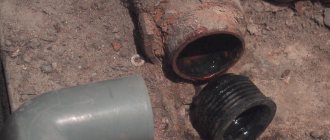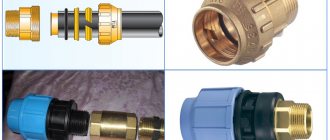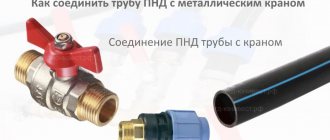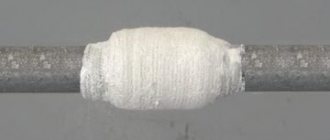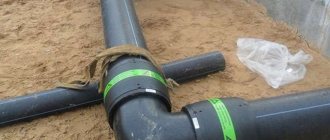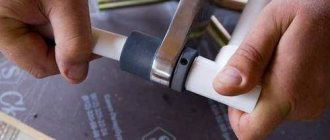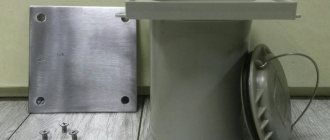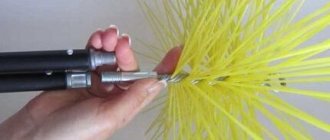In modern buildings, the internal sewage system is assembled from plastic pipes. They have a number of advantages and are easier to install, since there is a wide variety of fittings that allow you to make turns, connections and transitions from one diameter to another. The problem of replacing old rusted elements with polymer products is solved in a completely different way. In this case, you need an adapter for a cast iron sewer pipe, with which you can connect the plastic to the metal.
When is such a connection needed?
The need to make such a transition arises:
- when replacing old sewer pipes;
- when replacing a cast iron sewer tee, which takes up too much space;
- when inserting a plastic tee into a cast iron riser;
- when installing polymer wiring to new plumbing;
- when replacing cast iron batteries;
- during the construction of a private house, when it is necessary to “cut into” the central pipeline;
- when installing new or replacing old meters.
Advantages and disadvantages of such a connection
The advantages of transitional connection of PVC products to cast iron include:
- high technical characteristics of plastic products, lack of rust, lightness and ease of installation compared to cast iron pipes;
- less labor-intensive joining process compared to joining cast iron products;
- the ability to make the connection yourself;
- a variety of methods for installing polymer pipes with cast iron, each of which brings reliable results;
- no need to purchase expensive equipment, use welding, etc.;
- large selection of standard sizes of polymer pipes and connecting elements.
The disadvantage is the difference in heating temperatures of these materials. Plastic products heat up faster, and they begin to deform, which leads to loosening of some types of connections and loss of their strength.
For this reason, detachable connections of cast iron and plastic lose their reliability over time.
Removing cast iron pipes
The pipes are connected using press fittings. At one end of such a product there is a thread, and at the other there is a socket for connecting a plastic pipe. You will also need Teflon tape (FUM tape) or plumbing flax for sealing and two adjustable wrenches.
Installation steps:
- We unscrew the coupling or cut off a piece from the cast iron pipe in the place where it will be carried out
- connection with a plastic pipe.
- We cut the thread, if necessary, on the cut area.
- We clean the threads from dust and wrap tape or flax around it, lubricate it with silicone grease.
- We screw on the press fitting.
Advice!
Screw on the press fitting by hand, without a key, as it may crack with strong force. You can tighten it after turning on the water.
You can also connect a cast iron pipe to a plastic one using a cast fitting. For this:
- Degrease the joint area.
- We treat the joint with plastic glue and sprinkle it with sand, wait for the glue to dry completely.
- Clean the bell and degrease it.
- We treat with sealant.
- We install the sealing ring.
- We insert the narrow part of the fitting into the sealing ring.
- We insert the edge of the plastic pipe into the fitting collar.
Connection with rubber gaskets
This method is suitable if you managed to remove the old pipe from it and its edges and the inner surface remain smooth. The pipe should extend into the socket by an average of 5 cm. With this connection method, the sewer can be used immediately after all work is completed. Installation steps:
- we clean parts from rust, dirt, etc.;
- Coat the rubber adapter with sealant on the outside.
- insert the rubber adapter into the cast iron socket;
- insert the pipe into the cuff.
If pipes that do not have a socket are connected, then a plastic adapter is used. Then proceed as follows:
- cut off a piece, align the edges;
- put on the rubber adapter;
- coat the edge with sealant;
- We put a plastic adapter lubricated with sealant on top.
Silicone sealing
The gap formed when connecting pipes (up to 2 mm) can be sealed with plumbing silicone
This method is quite effective if you pay special attention to the bottom of the joint.
- Dry the joint area using a hair dryer.
- We fill the gap with silicone as deeply as possible, for this we use a special construction glue gun.
- We wait until the silicone dries, usually this happens in 3 - 5 hours.
Socket connection
For this type of connection, you need to buy a special adapter that is designed for installation in the socket. Such a part can be purchased at any hardware store; products with a diameter of 50 or 110 mm are usually required. But there are pipes of other diameters, so it’s better to decide in advance.
The connection process takes place in several stages:
- we clean all connected parts from dirt, dust and other things;
- coat them with sealant;
- We insert the adapter all the way into the cast iron socket;
- Insert a plastic pipe into the adapter.
This method is the simplest and most reliable, and if necessary, the connection can be disassembled and reassembled.
Flange connection
This method uses special connecting parts. In addition, the use of welding will be required, which does not always allow you to carry out the work yourself.
- We clean the pipe adjacent to the main pipe.
- We weld the metal flange part.
- Place the crimp sleeve on the workpiece.
- We connect the flanged parts, placing an O-ring between them, with bolts.
It is possible to carry out high-quality work in the event of repairs or planned replacement of cast iron pipes with plastic ones only by following the installation steps. I would also like to note that it is better to carry out this work in advance, rather than wait for an accident.
Video: transition from cast iron to plastic pipes, nuances and tricks in replacing plumbing fixtures, PVC pipes and sewerage
Connection methods
The choice of connection method is determined by the presence or absence of a socket in the cast iron segment.
If there is no socket or it is damaged and cannot be used, the optimal solution would be a threaded connection through a polymer adapter, which will have a thread at one end and a socket at the other for connecting to a plastic hose.
Along with this method, there are other technologies. Let's look at each method in more detail.
Application of rubber gasket
If the cast iron channel has a socket, use a simple connection method through rubber gaskets. They are rubber stepped cuffs of various diameters.
- The inside of the bell is thoroughly cleaned.
- Lubricate the edges of the bell and the outer surface of the cuff with sealant.
- The seal is placed tightly into the cross.
- Then the plastic input is inserted there until it stops, no less than 3 cm. The joint is treated again with sealant.
A similar method is often used when connecting the liner from the sink.
The transition using a rubber cuff is shown in this video:
Using a plastic adapter with a rubber seal
This connection is used when the cast iron pipe does not have a socket.
- Cut the end of the pipe straight with a grinder.
- Put a rubber ring on it, then a cuff.
- All this is coated with sealant.
- Next, a plastic adapter is inserted.
- A ring is installed on the adapter and the socket of the polymer pipe is put on.
Using a press fitting
The fitting connection is the most reliable, and at the same time the most labor-intensive to make. Its reliability is ensured by the threaded connection of the adapter coupling with the cast iron pipe. The transition coupling has a thread at one end and a socket at the other for a sliding connection with a polymer sleeve.
- A chamfer is cut at the end of the cast iron pipe, after which threads are cut to a depth of 5 cm.
- The thread is sealed by winding tow or FUM tape using plumbing paste.
- Screw the adapter onto the thread by hand so that the fitting does not crack. Later, after the start of operation, they tighten it with a key.
- A plastic pipe with a crimping collar is inserted into the socket at the other end of this coupling and crimped using a special hand press.
This video demonstrates a threaded connection:
Embossing with linen winding
Caulking has long been used for socket connections of sewer pipes.
- The inside of the cast iron socket is cleaned, making its surface as smooth as possible.
- Insert the end of a plastic pipe into it until it stops, wrapped in linen winding and lubricated with plumbing paste.
- Using a simple screwdriver, seal the cracks with winding. Fill two-thirds of the free space with sealant.
- The remaining space is covered with cement mortar with the addition of PVA glue.
- Leave the solution to harden at the junction for a day.
Currently, instead of cement mortar, silicone sealant is increasingly used, which, due to its plasticity, does not allow the connection to lose strength due to temperature changes. This is especially important when switching from cast iron to plastic, given the difference in their heating temperatures.
This photo shows how to properly caulk:
Silicone sealing
This method is very simple and takes very little time. It is used to seal cracks whose size does not exceed two millimeters.
- The bell must be cleaned and dried, for which a hair dryer is used.
- The connected end of the polymer pipe is wrapped with plumbing thread, inserted into the socket and the cracks that form around it are sealed with silicone.
- The silicone must be pushed deep down to the very end of the plastic.
- It is better not to use the pipeline while the sealant dries (about 5 hours).
Flange connection
This type refers to detachable connections. It is used when working with large diameter pipes, where it is difficult to cut threads and use threaded couplings. If necessary, it will be possible to disassemble and make repairs.
The work order is as follows:
- Use a grinder to cut the cast iron pipe straight.
- Clean the welding area from nicks.
- Weld a flange to the resulting pipe.
- A special crimp coupling is put on the attached plastic part, the flanged part of which is bolted to the cast iron flange. A seal is placed between the flanges.
How to properly connect a cast iron pipe to a plastic product?
To connect plastic to cast iron, it is advisable to use rubber cuffs and plastic adapters.
If cast iron has a socket, then you only need to purchase a rubber adapter. In another case, you will also need a plastic adapter.
To understand the process of connecting parts, consider a specific example, when two sockets are taken from the sewer riser, one is intended for a toilet and has a diameter of 110 mm, the second is for an apartment sewer with a diameter of 50 mm.
First you need to thoroughly clean the bell, removing dirt and rust, and then lubricate the inside of the rubber cuff with sealant. It is inserted into a cast iron socket, only after this the sewer pipe is inserted into the cuff.
In some cases, the bell is simply missing, and there is only a small section of the old product. If the edges of this segment are not even, then you should trim them using a grinder. A rubber cuff coated with sealant and a plastic adapter are put on top.
The first method of docking using a rubber gasket
If the cast iron pipe is easily removed, and the inside of the socket remaining from the riser is smooth, then you can use the joining method using a special sealant. In this case, the plastic pipe is inserted into the cast iron section by at least three centimeters, ideally it should be about eight centimeters.
Recommended reading: What should be the slope of a sewer pipe in a private house?
Using this method, you can quickly make a connection, after which you can immediately use the sewer system. Based on practice, it is worth saying that this type of connection will last at least 8 years without problems.
Typically, a sewer riser consists of two outlets: one for a toilet with a diameter of 110 mm, and the second for an apartment sewer with a diameter of 50 mm. In any case, the connection will be carried out according to one algorithm, in which you need:
- remove rust and dirt from the bell;
- install the cuff on top, and apply sealant to its outer transition;
- the rubber adapter is inserted into the cast iron socket;
- at the last stage, a new plastic sewer pipe is inserted into the cuff.
If there is a need to connect a pipe without a socket, then you will need to use a plastic adapter. In such a situation, the sequence of actions is different:
- The edges of the cast iron pipe are leveled using a grinder;
- a rubber adapter is placed over this area;
- the edge of this pipe with the adapter is coated with sealant;
- A plastic adapter is placed over the treated area, which is also lubricated with a sealing compound.
The cuffs and adapters used must match the dimensions of the pipes. The sequence of connecting cast iron and plastic pipes of different diameters using this method is no different.
Connection using caulking with sanitary linen winding
This connection method is mostly used for joining cast iron pipes. but, despite this, it can be used for a mixed type of docking. If you prefer this option, you need to perform a number of steps:
- on a plastic pipe, the joint areas are wrapped in several layers with plumbing tape;
- Using a narrow spatula or a wide screwdriver, this material must be pushed well into the gap formed at the junction of the pipes;
- The transition to a cast iron section must be coated with a polymer-cement composition several times. This composition is prepared on the basis of cement, water and PVA glue;
- Upon completion of such work, it is not recommended to use the sewer system for at least one day.
Recommended reading: Hydrodynamic pipe cleaning
A joint made using this technology will be reliable and of good quality. Previously, this method was used quite often, even before the advent of silicone-based sealants. Even now, this is a convenient solution for connecting a plastic pipe to a cast iron pipe under a washbasin or sink. If leaks appear after some time, this has nothing to do with the docking.
GOSTs and standards
The production and dimensions of cast iron sewer pipes are regulated by GOST 6942-98.
For plastic pipes, there are many GOSTs and SNiPs that regulate their individual characteristics.
Each type of polymer, depending on the scope of application (sewage, heating or water supply), has its own GOST standards.
For example, the characteristics and dimensions of plastic pipe products intended for cold and hot water supply and heating systems in buildings for various purposes are regulated by GOST R 52134-2003.
Difficulties in joining different materials
From the outside it may seem that connecting a cast iron sewer pipe to a plastic one is a simple, purely technical procedure. However, materials differ significantly in their physical and operational characteristics, and this affects the progress of work.
The main problem with cast iron is its fragility. Communications made of this metal require extremely careful handling. Excessive physical force using a hammer or sledgehammer will often cause a large piece of the pipe to break off, and this will not be the result you expected.
The brittleness of cast iron can cause problems Source eurobion.info
That is why the pipes are carefully cut with a grinder, and the cut line is cleaned of burrs, rust and dirt. Also, do not break off a cut cast iron pipe; Most likely, it will break off not where you expect, and you will have to cut it again.
The coefficients of thermal expansion of metal and polymer have different values. This cannot be ignored when installing a combined sewer system if you want to get sealed joints with a long service life.
The diameters of plastic and cast iron pipes according to GOST are not always 100% identical. If it is not possible to select pipes of the same diameter, auxiliary elements are used: compensators, couplings, fittings. To improve the quality of the connection, sealants are used (preferably silicone-based), and the threads are sealed with FUM tape (made of Teflon). The choice of sealants is extensive. In addition to silicone, Portland cement, epoxy resin, bitumen, technical sulfur, and asphalt mastic are used.
Fluoroplastic (FUM) tape – film seal Source sigma.ua
See also: Catalog of companies that specialize in engineering systems (heating, water supply, sewerage and others) and related work
Diameter standards
For domestic domestic sewerage, cast iron pipes with an internal cross-section of 50 mm (DN) and 100 mm (DN) are used.
The dimensions of external sewerage are determined by SNiP standards. In intra-block networks, a diameter of 150 mm is used, in street networks - 200, 250 mm.
Polypropylene products are produced in accordance with GOST 26996-86. The standard has not established a specific size for the sewer sector. But in practice, the following diameters of sewer plastic pipes have developed: 32, 40, 50 and 110 mm.
For polyethylene pipes, working diameters - 40, 50, 90 and 110 mm - were determined by GOST 22689.2-89.
For PVC products, the cross-section of sewer products is regulated by GOST 51613-2000. Its requirements: PVC pipes must have a Ø from 10 to 315 mm.
In order to make drainage, lay external sewerage, septic tank pipes, you will need products with a cross-section of 110-200 mm.
Silicone sealing
A fairly simple and relatively cheap connection method, but it is used only when sealing joints where the size of the cracks is no more than 2 mm. The installation process is as follows:
- Before sealing, the pipe socket is thoroughly cleaned and dried with a hot air gun.
- A sealing thread is wound onto the connected section of the polymer pipe.
- The wrapped section is inserted into the socket.
- The gaps are sealed with silicone, which is pushed to the end of the plastic product.
Application of a plastic transition to a cast iron pipe
Step-by-step technique for connecting pipes with your own hands
The technology for performing the work includes the following stages:
- Preparatory stage.
- Selection of tools and materials.
- Dismantling part of the old pipeline.
- Preparing two parts of pipes for connection.
- The operation of joining parts.
- Required tools and materials
At the first stage, the location of the connection is determined and the method of its implementation is chosen. Make the necessary measurements and determine the need for materials.
Required tools and materials
Polymer pipes are purchased in the appropriate size. To connect the toilet to the crosspiece, you will need elements with a diameter of 110 mm; for laying pipes to a sink or bathtub, the best option would be plastic with a diameter of 50 mm.
In accordance with the project, the necessary connecting materials are purchased: seal, fitting, sealant, etc.
Select the necessary tool. It may include:
- a set for dismantling the cast iron part - a hacksaw or grinder, a mallet, possibly with a rubber pad;
- screwdriver;
- spanners.
To cut the thread you will need a thread cutter.
For plastic joints you will need either a hand press or a welding machine - an iron.
Video description
About connecting to a cast iron sewer in the following video:
Flange connection
The flange has proven itself well when joining large-diameter pipes, where previous methods are not suitable. Sections of the sewer system are connected using flanges: flat parts that look like a ring or disk. The holes are evenly spaced on the flanges; bolts (less often studs) are usually used as fasteners.
To switch from plastic to cast iron in the sewer system, welding work will be required, since the metal flange part must be welded to the main pipe pipe. The flange parts are connected using a crimp coupling and bolts; the space between them is filled with a sealant.
Installation of flange connection Source technicalservice59.rf
Installation features
If you have to disassemble and remove the old part of cast iron from the socket, you should be careful: cast iron is a brittle metal and the socket can crack if hit with a hammer or by forcefully turning the piece being removed in it. Caulking may require the use of a blowtorch or torch if the joint is filled with sulfur. You cannot do without a respirator or gas mask here.
For insertion into the sewer riser and transition from cast iron to plastic, compensating pipes are used. They compensate for polymer deformation due to temperature changes. And in combination with a corrugated sleeve they can give the necessary slope to the outlet.
The wiring always starts from the riser.
Switching from cast iron to plastic
Within reasonable limits, all the described sealing methods can be combined with each other. No matter how paradoxical it may sound, often a combination of various methods greatly increases the reliability of connections. For example, a gap that is too wide can be eliminated with a rubber cuff with simultaneous caulking, and a classic caulking can be sealed not with a polymer cement mixture, but with plumbing silicone. The main thing in the process of work is to be guided by the principle of reasonable sufficiency and to understand that the plasticity of the sealing elements is the key to reliable and durable operation of the entire sewer system.
Hello! Today I will tell you how to make the transition from a cast iron pipe to a plastic one.
Frequent connection problems and errors
Often they try to insert rubber seals into the socket without proper preparation of its interior. You must understand that any bump on its surface can cause a leak. The inlet part of the cast iron must be thoroughly cleaned mechanically.
Insufficient drainage slope from plumbing fixtures to the riser causes constant and frequent stagnation in the sewer system.
The reason for poor tightness of connections is often the lack of basic lubrication, an insulating layer, or a loose or overtightened threaded connection.
Expert advice
The insertion into the sewer riser is carried out using a polymer tee. When assembling a gravity sewer system, the sockets must be directed against the flow of waste.
When tightening a threaded connection, be sure to wrap tow around the threads and lubricate it with plumbing paste. Tow or FUM tape is wound along the thread in the direction of twisting.
The plastic channel does not provide complete sound insulation. The problem can be solved by installing an additional protective box.
Due to the difference in thermal expansion coefficients in cast iron-plastic joints, it is correct to use silicone as a sealant.
Using the rubber cuff
The method of using a rubber cuff is the simplest and most cost-effective option. This ensures a high degree of elasticity of the connection, which is very important when using dissimilar materials that differ from each other in terms of linear expansion coefficient.
The flexibility of the ring reduces the risk of deformation of the structure to a minimum and ensures uninterrupted operation for an average of 10 years. At the same time, the cuff belongs to the products of the low price segment. This set of qualities makes its use very practical.
The method is most optimal when switching to cast iron with a socket, which simplifies the process of installing polymer products.
Using a rubber cuff to switch to cast iron
A combination of several pipe joining methods
To guarantee protection from leaks, a combination of several connection methods is used.
Thus, joining on a rubber gasket can be supplemented by coating the cracks with either silicone or a cement-sand mortar with PVA glue.
When connected to the toilet, the corrugated sleeve is wrapped with linen winding and then silicone is applied to it.
This photo shows a combination of caulking with silicone sealant:
Working with cast iron and ceramic pipes
Since the methods for working with these types of pipes are not very different, it makes sense to study them together.
Such pipes are also equipped with sockets, so they are simply inserted into each other. The connection turns out to be loose, and the gaps should be eliminated using ordinary tow. After this, you should use any waterproofing agent: silicone sealant, mastic or cement.
Cement is most often used, which is due to its low cost. It is preferable to take a building material marked 400. To prevent cracks from forming at the joint, you need to wet a rag and tie it over your joint, and then moisten it. Since cement, when drying, absorbs liquid, such a procedure is necessary.
